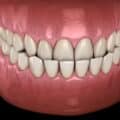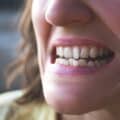An overbite, or “deep bite”, occurs when the upper front teeth significantly overlap the lower front teeth. While it’s common to have a slight overbite, a pronounced one can lead to various health and dental complications if untreated. Overbites rank among the most prevalent orthodontic issues globally, affecting people of all ages and often requiring professional intervention to prevent or address associated challenges.
Correcting an overbite is essential for both aesthetic and health reasons. Left untreated, severe overbites can contribute to jaw pain, enamel erosion, speech issues, and even breathing difficulties, impacting overall comfort and quality of life. Addressing an overbite can help relieve these symptoms, improve jaw alignment, and enhance facial symmetry, resulting in a healthier and more confident appearance.
The New Zealand Association of Orthodontists (NZAO) comprises orthodontic specialists dedicated to delivering high-quality care for a variety of dental concerns, including overbite correction. With advanced diagnostic tools and customised treatment plans, they help patients achieve optimal dental health and aesthetics, offering reliable solutions for both functional and cosmetic needs.
What is an Overbite?
An overbite is defined by the vertical overlap of the upper front teeth over the lower front teeth. While a slight overlap is normal and often goes unnoticed, a more severe overbite can lead to significant functional and aesthetic challenges. Excessive overlap may begin to interfere with chewing, speaking, and even jaw alignment, making correction necessary to preserve dental health and comfort over time.
Types of Overbites
- Skeletal Overbite: Caused primarily by jaw misalignment, this type of overbite often has genetic roots. When an overbite involves the bone structure, it may require more complex orthodontic or surgical intervention to achieve balanced alignment.
- Dental Overbite: Unlike skeletal overbites, a dental overbite results from the misalignment of teeth rather than the jaw. This type of overbite can arise from overcrowded teeth, improper tooth positioning, or childhood habits like thumb-sucking. Treatment for dental overbites often includes braces or clear aligners to gradually shift teeth into the correct position.
Symptoms of an Overbite
Overbites can present various symptoms, and their intensity typically depends on the severity of the overlap:
- Jaw Misalignment: A pronounced overbite can give the appearance of a protruding upper jaw, affecting facial symmetry.
- Crowded Teeth: Misalignment can cause overcrowding, making it challenging to maintain proper oral hygiene and increasing the risk of decay and gum disease.
- Jaw Pain: Severe overbites can lead to discomfort or pain in the jaw joints and surrounding muscles, often linked with temporomandibular joint (TMJ) disorders.
- Frequent Headaches: Chronic muscle tension associated with an overbite can result in headaches, particularly around the temples and forehead.
Causes of Overbites
An overbite can develop due to a combination of genetic, behavioural, and developmental factors. Identifying the cause is essential in determining an effective treatment approach, as certain overbites respond better to early intervention or specific behavioural changes.
Genetics
Family history strongly influences jaw structure and tooth alignment, with skeletal overbites often being inherited. Although genetic factors cannot be changed, effective orthodontic treatments are available to address and correct inherited dental characteristics.
Childhood Habits
Certain early habits can have a long-term impact on dental alignment, contributing to overbite formation:
- Thumb-sucking and Pacifier Use: Prolonged thumb-sucking or pacifier use can place pressure on the upper front teeth, pushing them forward and creating an overbite. Limiting these habits after infancy can help prevent alignment issues.
- Extended Bottle Feeding: Bottle feeding beyond infancy, especially when mimicking thumb-sucking, can also affect tooth and jaw alignment, increasing the likelihood of developing an overbite.
Poor Dental Habits
- Teeth Grinding (Bruxism): Grinding places excessive stress on the jaw, often shifting teeth and contributing to an overbite.
- Nail-biting: Although seemingly minor, nail-biting can, over time, exert enough pressure on the teeth to cause gradual misalignment.
Developmental Factors
- Jaw Growth Discrepancies: Variations in the growth of the upper and lower jaws can lead to overbites if one jaw develops at a different rate or angle than the other.
- Poor Posture: Forward head posture can place strain on the jaw muscles over time, impacting alignment.
- Mouth Breathing: Chronic mouth breathing, often due to allergies or nasal obstructions, may influence tongue positioning and jaw growth, increasing the risk of an overbite.
Health Risks and Long-term Impact of Untreated Overbites
An untreated overbite can lead to several complications, affecting physical comfort, appearance, and even mental well-being. Timely correction of an overbite can prevent or alleviate these health risks.
Dental Health Risks
- Increased Decay and Gum Disease: Misaligned teeth complicate effective brushing and flossing, making decay and gum disease more likely.
- Enamel Wear: Misalignment causes excessive friction on tooth enamel, wearing it down and increasing vulnerability to decay and tooth sensitivity.
Physical Discomfort
- Chronic Jaw Pain and TMJ Disorders: The pressure from misaligned teeth strains the jaw, often leading to pain and, in some cases, TMJ disorders.
- Frequent Headaches: Jaw misalignment can result in tension headaches and even migraines.
- Speech Challenges: Overbites can alter the way the teeth and tongue interact, affecting speech clarity and potentially requiring both orthodontic treatment and speech therapy.
Aesthetic and Psychological Impact
- Facial Profile: Overbites may cause facial asymmetry, such as a protruding upper jaw or receding chin.
- Self-confidence: A pronounced overbite can impact self-image. Correcting it not only improves aesthetics but can also enhance confidence and social interactions.
Overbite Treatment Options
A range of effective treatments is available for children and adults. Orthodontists provide customised treatment plans suited to age and the specific characteristics of each overbite, aiming for optimal outcomes.
Treatment Options for Children vs. Adults
- Children: Early intervention is ideal, as a child’s developing jaw is more responsive to orthodontic adjustments. Appliances may guide jaw growth, preventing or minimising a severe overbite.
- Adults: Though highly effective, adult treatment may require a more comprehensive approach as the jawbone is fully developed. Braces, clear aligners, or, in severe cases, surgery may be needed.
Common Treatments
- Braces: Braces apply gentle, steady pressure to realign the upper and lower teeth over time.
- Invisalign and Clear Aligners: Removable and discreet, clear aligners are popular for adults who prefer an alternative to traditional braces.
- Orthodontic Appliances: Expanders, retainers, and bite correctors are often used in children to guide teeth and jaw alignment.
- Surgery: Severe skeletal overbites sometimes require jaw surgery in conjunction with orthodontic treatment for effective realignment.
Duration of Treatment
The time required for overbite correction depends on the severity:
- Mild to Moderate Overbites: Generally 12–24 months with braces or aligners.
- Severe Overbites: Complex cases may require up to 36 months, especially if surgery is necessary.
Long-term Benefits of Correcting an Overbite
The benefits of overbite correction extend well beyond immediate relief from discomfort or aesthetic concerns, positively impacting long-term dental and overall health.
- Improved Oral Health: Aligning teeth and jaws improves oral hygiene access, reducing decay, gum disease, and enamel wear.
- Enhanced Facial Profile: Corrected overbites create facial symmetry, with a balanced jawline and overall improved aesthetics.
- Better Quality of Life: Patients often experience enhanced chewing ability, reduced speech issues, and greater confidence in social situations.
- Prevention of Chronic Health Issues: Proper alignment can alleviate chronic jaw pain, reduce TMJ disorder risks, and minimise tension headaches associated with misalignment.
FAQs
Patients often have questions regarding overbite treatment. Here are answers to some of the most frequently asked queries:
- Can overbites be corrected without braces?
Yes, mild overbites can sometimes be corrected with clear aligners or removable appliances, especially in children. However, moderate to severe overbites typically require braces or surgical correction. - What age is best for treating an overbite?
Ages 7 to 12 are ideal for addressing overbites since the jaw is still developing. However, effective treatments are also available for teens and adults, though they may take longer. - Are there risks associated with overbite treatment?
Overbite correction is generally safe, with minimal risks when managed by an orthodontist. Potential side effects may include temporary gum sensitivity or a slight chance of tooth movement if retainers aren’t used as advised.
Choosing an Orthodontist for Overbite Correction
Selecting a skilled orthodontist is vital for successful overbite correction. Orthodontists bring specialised expertise and advanced training to dental alignment concerns.
Why Choose an NZAO Orthodontist?
NZAO members are highly trained and adhere to the highest standards of care, using advanced techniques to ensure safety, effectiveness, and patient satisfaction.
Finding the Right Orthodontist
When choosing an orthodontist, consider experience, reviews, and a patient-centred approach. A strong track record in treating overbites is vital.
Consultation Process
During a consultation, the orthodontist will assess the overbite’s severity through examination and imaging. They’ll create a personalised treatment plan, allowing patients to address questions and gain a clear understanding of their treatment journey.
Why Addressing an Overbite is Worth It
Overbite correction provides numerous health and aesthetic benefits, from reducing the risk of decay and jaw pain to enhancing facial symmetry and self-confidence. Consulting with a registered orthodontist is a critical first step. You can use NZAO’s Orthodontist Finder tool on its website to connect with a qualified professional near you and take the first step toward a healthier, more confident smile.
Have you read these articles?
 Braces Or Clear Aligners: Which Is The Best Overbite Treatment?
Braces Or Clear Aligners: Which Is The Best Overbite Treatment?
 Can Invisalign Correct an Underbite? A Complete Guide
Can Invisalign Correct an Underbite? A Complete Guide
 Helpful Guide to How Christchurch Orthodontists Fix Teeth Crowding
Helpful Guide to How Christchurch Orthodontists Fix Teeth Crowding
 How Crooked Teeth Can Affect Your Oral Health: What You Need to Know
How Crooked Teeth Can Affect Your Oral Health: What You Need to Know
 Types of Adult Braces in New Zealand: A Comprehensive Guide
Types of Adult Braces in New Zealand: A Comprehensive Guide






